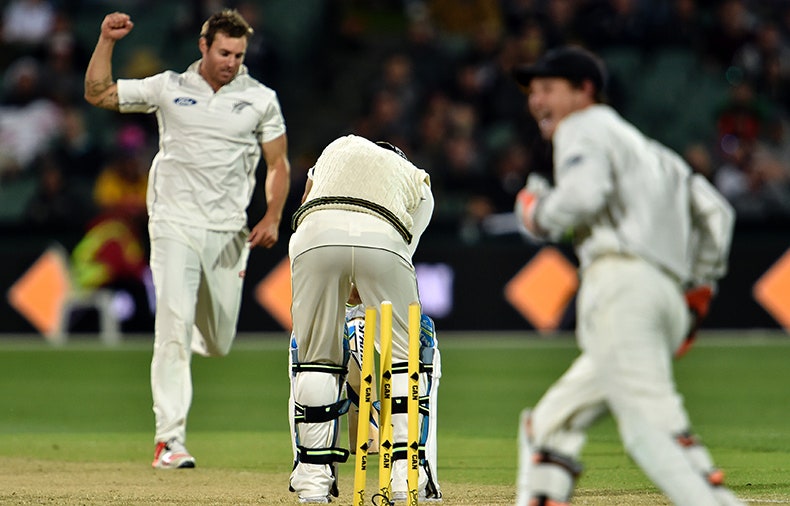Test cricket has stood the test of time, fading attention spans and the revolution of the sport into snackable content with the rise of T20 cricket. But increasingly the five day format has been given varying degrees of death warrant from “slow decay” to “on life support” as it fought to retain relevance. It’s hard to deny test cricket was waning in popularity - long, complicated, and often finishing without a winner after five days of contest, the sports purported highest level has become a niche passion for cricket’s most traditional fans.
There’s been attempts to breath life into the gentleman's game. In November 2015 I was at the Adelaide Oval for the first ever day-night test match, played between Australia and New Zealand. Fans were able to roll in after work to see the pink ball swing under the lights. The Friday session was filled with locals having after-work drinks at the Oval instead of the pub. It attracted the biggest crowds Adelaide had seen at the cricket since the 1932 Ashes series. The match was filled with tension and controversy. But then cricket went back to its tried and true, and tired ways, the Adelaide test a flash in the dark. There’s been just five tests under lights since 2015.
But, earlier this month when the CEOs of the International Cricket Committee met in Auckland, they announced an attempt to rescue test cricket from irrelevance with the launch of the Test World Championship in 2019 (22 years after the idea was originally proposed at the 1997 ICC conference by Ali Bacher and Clive Lloyd).
Over two years each of the top nine teams will play six series, with three at home and three away. Points will be awarded for winning a match and winning a series. The top two teams after the round robin will play a final at Lord’s in 2021. Details of the points system have leaked to the Sydney Morning Herald - each series would be allocated 100 points, regardless of whether it was played over two or five matches. Of the 100 points, 60 would be dedicated to the series result which would be split if drawn, and 40 to the results of the individual matches.
“Bringing context to bilateral cricket is not a new challenge, but this is the first time a genuine solution has been agreed on,” says ICC Chairman Shashank Manohar.
Reducing the length of test cricket to four days has debated almost as long as the world championship. The four day Test experiment, which was also announced in Auckland, is another attempt to preserve the formats presence in cricket’s future and inject pace and vibrance to the long form game. The first shortened match will be played on Boxing Day between South Africa and Zimbabwe and Ireland and Afghanistan, test cricket’s newest inductees, will play in the four day format.
“Throughout the discussions about the future of Test cricket it became clear that whilst context is crucial we must also consider alternatives and trial initiatives that may support the future viability of Test cricket. The trial is exactly that, a trial, just in the same way day-night Tests and technology have been trialled by Members,” says ICC CEO, Dave Richardson.

But is context is enough to save Test cricket from itself? When the sports is against the ropes in a Royal Rumble against broadcasters and fans hungry for a quick fix, and stadiums and cricket boards hungry for cash, it feels like the context of a world championship is too little too late. The five day format has been accused of becoming stagnant and slow moving, but the world championship fails to celebrate the existing pieces of Test cricket that are dynamic and absorbing. The two year league doesn’t provide for all nine teams to play each other, and cricket’s greatest rivals, India and Pakistan, are highly unlikely to face in a series.
And context won’t solve the fact that tests are increasingly lopsided results. There’s massive need for investment in creating a contest that is more captivating due to closely fought matches. For example suggested changes to how the toss can lessen the advantage of the home team who gets to prepare the conditions to suit themselves, have been shelved for now.
Some nations will continue to play many more tests than others, which despite the context will continue to accelerate the gaps between nations. While Australia will play five tests against England for the Ashes series alone this summer, New Zealand will only play only four Tests across the whole home summer season against England and the West Indies. And the exclusion of Zimbabwe, Ireland and Afghanistan in a second tier with the potential for promotion into the world championship, instead appears to constrict the development of the game as a global sport. Without the opportunity to play the top teams cricket, and especially test cricket seems trapped.
Who’s winning is the eternal cricket question that often impossible to answer. But even with the introduction of the Test World Championship there’s a distinct feeling that test cricket is still losing.


